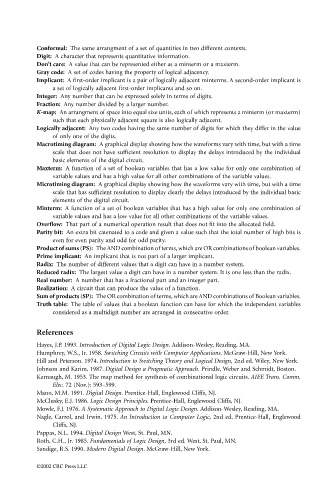Page 1052 - The Mechatronics Handbook
P. 1052
Conformal: The same arrangment of a set of quantities in two different contexts.
Digit: A character that represents quantitative information.
Don’t care: A value that can be represented either as a minterm or a maxterm.
Gray code: A set of codes having the property of logical adjacency.
Implicant: A first-order implicant is a pair of logically adjacent minterms. A second-order implicant is
a set of logically adjacent first-order implicants and so on.
Integer: Any number that can be expressed solely in terms of digits.
Fraction: Any number divided by a larger number.
K-map: An arrangment of space into equal size units, each of which represents a minterm (or maxterm)
such that each physically adjacent square is also logically adjacent.
Logically adjacent: Any two codes having the same number of digits for which they differ in the value
of only one of the digits.
Macrotiming diagram: A graphical display showing how the waveforms vary with time, but with a time
scale that does not have sufficient resolution to display the delays introduced by the individual
basic elements of the digital circuit.
Maxterm: A function of a set of boolean variables that has a low value for only one combination of
variable values and has a high value for all other combinations of the variable values.
Microtiming diagram: A graphical display showing how the waveforms vary with time, but with a time
scale that has sufficient resolution to display clearly the delays introduced by the individual basic
elements of the digital circuit.
Minterm: A function of a set of boolean variables that has a high value for only one combination of
variable values and has a low value for all other combinations of the variable values.
Overflow: That part of a numerical operation result that does not fit into the allocated field.
Parity bit: An extra bit catenated to a code and given a value such that the total number of high bits is
even for even parity and odd for odd parity.
Product of sums (PS): The AND combination of terms, which are OR combinations of boolean variables.
Prime implicant: An implicant that is not part of a larger implicant.
Radix: The number of different values that a digit can have in a number system.
Reduced radix: The largest value a digit can have in a number system. It is one less than the radix.
Real number: A number that has a fractional part and an integer part.
Realization: A circuit that can produce the value of a function.
Sum of products (SP): The OR combination of terms, which are AND combinations of Boolean variables.
Truth table: The table of values that a boolean function can have for which the independent variables
considered as a multidigit number are arranged in consecutive order.
References
Hayes, J.P. 1993. Introduction of Digital Logic Design. Addison-Wesley, Reading, MA.
Humphrey, W.S., Jr. 1958. Switching Circuits with Computer Applications. McGraw-Hill, New York.
Hill and Peterson. 1974. Introduction to Switching Theory and Logical Design, 2nd ed. Wiley, New York.
Johnson and Karim. 1987. Digital Design a Pragmatic Approach. Prindle, Weber and Schmidt, Boston.
Karnaugh, M. 1953. The map method for synthesis of combinational logic circuits. AIEE Trans. Comm.
Elec. 72 (Nov.): 593–599.
Mano, M.M. 1991. Digital Design. Prentice-Hall, Englewood Cliffs, NJ.
McClusky, E.J. 1986. Logic Design Principles. Prentice-Hall, Englewood Cliffs, NJ.
Mowle, F.J. 1976. A Systematic Approach to Digital Logic Design. Addison-Wesley, Reading, MA.
Nagle, Carrol, and Irwin. 1975. An Introduction to Computer Logic, 2nd ed. Prentice-Hall, Englewood
Cliffs, NJ.
Pappas, N.L. 1994. Digital Design West, St. Paul, MN.
Roth, C.H., Jr. 1985. Fundamentals of Logic Design, 3rd ed. West, St. Paul, MN.
Sandige, R.S. 1990. Modern Digital Design. McGraw-Hill, New York.
©2002 CRC Press LLC

